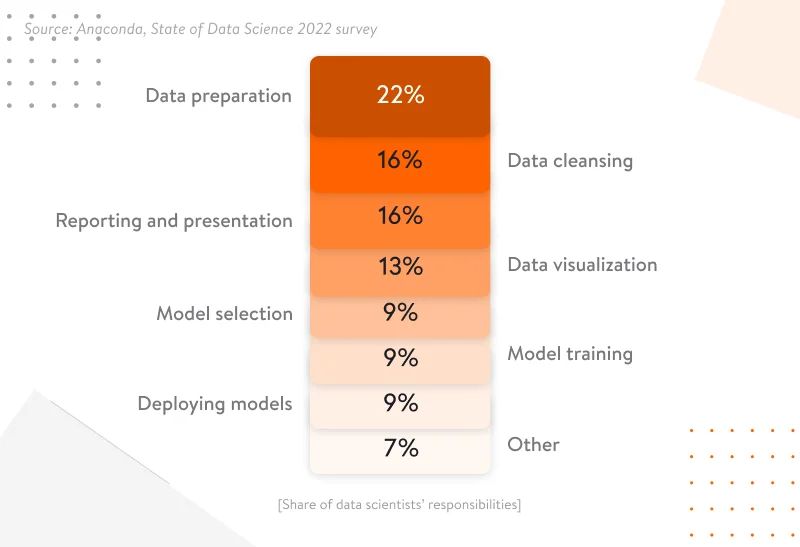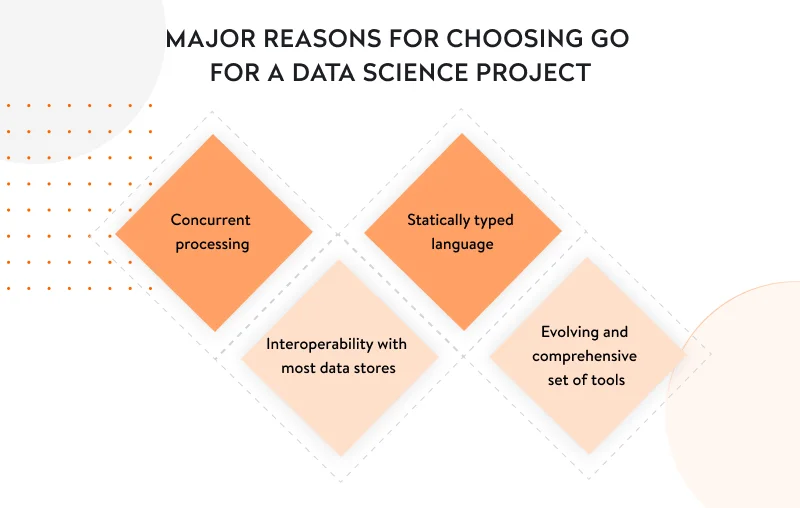Both Rust and Go are relatively new programming languages, but as Go has been in use for a little longer (since 2009) than Rust (released in 2015), it’s considered a more widespread programming language. Thus, when comparing Rust vs Go in terms of popularity, Go wins. However, Rust is gradually evolving and getting more mature with the help of its growing community.
In this article, we aren’t going to answer the question Should you use Rust or Go? They’re both excellent and ahead of their time, and many prominent companies (such as Google) use both languages. It’s just that in some situations, Rust fits better than Go, and in other cases Go is a better choice. In particular, we will focus on the performance of both languages.
Go vs Rust: similarities and differences
Modern languages like Rust and Go aim at solving issues of older programming languages like C and C++. Rob Pikes, a co-creator of Go, puts it this way: “In fact, a major reason for creating Go was the difficulty of doing concurrent computation in C++ at the time.”
Plus, the majority of software bugs are related to memory safety, and Rust and Go emphasize reliable memory management.
However, one of the most critical differences between Rust and Golang is the approach of the teams behind them. After the release of Go version 1, the Go creators made a promise that version 1 would be the major milestone, and that after that point there wouldn’t be many changes to the language. This approach helps to keep Go stable and simple. On average, no more than two features are added to Go per year.
On the contrary, Rust is a complicated language, with an average of almost 15 new features added each year. This may mean the language is rapidly evolving. At the same time, such frequent updates constantly disrupt the development process, requiring Rustaceans to renew their knowledge of the language.
Let’s compare Golang vs Rust in terms of certain characteristics to better spot the core differences and similarities between them and define a Go vs Rust benchmark.

Memory management. The major difference between these languages lies in memory management. Although both languages emphasize memory efficiency and aim at preventing memory leaks, Go uses a garbage collector and Rust goes a step further by introducing the ownership and borrowing model along with the Resource Acquisition Is Initialization (RAII) concept. Additionally, the Rust compiler, rustc, is efficient at identifying memory-associated bugs at compile time.
Go vs Rust performance. Both languages are fast and ensure high software performance. However, Rust allows for zero-cost abstractions, meaning you can use some high-level programming concepts (generics, collections) but not at the expense of your program’s performance — only at the cost of a longer compile time. Rust’s zero-cost abstractions feature allows for the development of extremely high-performance programs. Go doesn’t provide such a feature. Golang is not intended to be extremely high-performance but rather to have sufficient performance to write a program quickly without thinking too much about speed. For a closer comparison of the performance of Rust and Go, you can check out this Rust vs Go performance benchmark.
Read also: How to monitor the performance of your Go application
Learning curve of Go language vs Rust. Becoming productive with Go is much easier and takes less time than becoming productive with Rust. Many developers find it harder to understand Rust — especially its memory safety rules, type conversions, and type checks. All of that makes Rust a more challenging programming language compared to Go.
Rust vs Go speed at compile time. Because of all the compiler checks that Rust runs, it may take longer to develop software in it. With Go, it can be faster to develop an initial prototype, but debugging and testing can be cumbersome and take longer. When developing in Rust, you may need more time for development but have fewer worries during deployment and testing because the compiler won’t allow you to compile the code with bugs.
Deployment. When it comes to deployment, the Rust vs Go benchmarks are quite similar. Both languages generate a static binary ready for deployment. The Golang compiler is faster, but the Rust compiler makes code more optimized.
Go vs Rust concurrency. For Go, concurrency is a critical area of focus. This language aims at enabling simple and efficient concurrency with the help of goroutines, a lightweight thread managed by the Go runtime. With Rust, concurrency is enabled with the help of the Async/Await paradigm and threading, which suit different use cases. Thus, when it comes to Rust concurrency vs Go concurrency, ensuring efficient concurrency with Go is much simpler because all functions are asynchronous coroutines.
Use in embedded devices. In this battle of Rust vs Golang, Rust completely beats Go when it comes to embedded devices. Rust is ideal for embedded systems programming. It runs fast directly on hardware.
This was a brief comparison of key characteristics of Rust and Go. If you’re interested in comparing Go with other languages, check out our article on the differences between Go and Node.js.
Sometimes Rust’s promising benefits may convince businesses to switch from Go to Rust. Let’s have a look at such an example and find out the reason for the switch.
Go vs Rust performance: example of switching from Go to Rust

Two years ago, Discord, the developer of an instant messaging application for gamers, switched their Read State service (necessary for keeping track of all messages and channels users read) from Go to Rust.
The Discord team decided to switch to Rust because with the Go implementation, the Read State service did not meet product requirements. Read State enforces tens of thousands of database writes per second. With Go, service latency and CPU spikes happened almost every two minutes. The reason is that instead of freeing memory immediately after it’s out of use, the memory is occupied for a bit until the garbage collector can determine if it’s truly out of use, slowing the program down. Switching to Rust allowed Discord to drastically improve service performance thanks to a more efficient memory management model.
However, this doesn’t necessarily mean that every business should think about switching to Rust. You should switch to Rust only if there is a valid reason for doing so. In the next section, we consider when Rust and Go can be used at their best.
When to use Rust vs Go
Rust and Go are general-purpose languages suitable for systems programming. However, Rust is a more versatile systems programming language, while Go is suited only for some system types.
Brief overview of Go use cases
Since Go has an automatic garbage collector, it’s usually frowned upon to call it a true systems programming language. But there are systems for which Go can be a good fit: for instance, container technologies such as Docker and Kubernetes, database systems, and all kinds of cloud infrastructure.
Typical Go use cases are as follows:

Cloud computing. When it comes to migration or deployment in the cloud, concurrency is critical. And as we’ve established in the first section of this article comparing the Rust language vs Go, when it comes to concurrency, Go is the winner. Go perfectly fulfills concurrency needs, particularly those required for microservices architectures, scalable applications, and cloud solutions. Explore our expertise in SaaS migration strategy.
Web application development. Go integrates well with all other modern tools and databases to quickly build scalable web solutions. This language allows for fast deployment on various platforms thanks to compiling as a static binary. When it boils down to Rust vs Go for web development, both languages are winners.
Command-line interface (CLI). Thanks to fast compilation times, Go is well-suited for developing CLI applications. Go offers many convenient tools and libraries, such as Cobra and Viper, for building CLI applications. GitHub used Go for creating one of its CLI tools.
DevOps and SRE solutions. The Go programming language is capable of enhancing DevOps and SRE environments. In this respect, Go is faster and easier to debug than Python. With Go, it’s possible to develop server maintenance software, write update scripts, and create batch processing tools. For instance, Drone is a continuous delivery system written in Go.
For a more in-depth analysis of the Go programming language, read this article.
Top companies that use Go: BBC, Netflix, Twitter, Twitch, Dropbox, Intel, Facebook
Read also: How to use WebSockets in Golang: best tools and step-by-step guide
Typical Rust applications
Rust is perfect for developing operating systems, drivers, kernels, file systems, gaming engines, large and embedded distributed systems, and libraries that perform heavy mathematical computations. With Rust, it’s possible to develop extremely memory-efficient, high-bandwidth, and low-latency software.
Among common Rust use cases are the following:

Microcontroller- and RTOS-based embedded systems. Rust is great for microcontroller programming and real-time operating system (RTOS) embedded systems. The possibility to use high-level programming concepts and memory safety guarantees makes Rust a perfect solution for embedded systems. Plus, Rust has a robust package management solution (Cargo) that makes embedded development much easier than in the C language. An example of an RTOS-based embedded system written in Rust is Drone OS.
Edge computing and IoT. Thanks to Rust’s high computational power, implementing this language for edge computing and IoT applications is especially beneficial. Rust can enable fast data capturing and processing. For instance, the Dwelo team (a smart home IoT startup) rewrote the code for their IoT platform in Rust. Their original Python code had grown significantly over the years, and the company needed a secure and fast substitute for Python. Rust appeared to be the right choice, as it’s easy to maintain and thread-safe. Speaking of the Internet of Things systems development, it’s also important to understand the importance of IoT testing.
Read also: Preventive maintenance IoT expertise
Developer tools. Like Go, Rust is great for creating CLI applications and diverse libraries for developers. Rust can also be used for CI/CD and automation tools. For example, Sandstorm (an open-source platform for self-hosting web apps) wrote the back end of their Collections application completely in Rust to ensure a fast startup time and a small memory footprint.
Web services. Rust is capable of increasing the performance and reliability of any application on the server side, again proving that in the category of Go vs Rust for web development, both languages are great. For example, news aggregator The Daily Edit is using Rust for its analysis engine and web back end.
Top companies that use Rust: Mozilla, Meta, Amazon, GitHub, Microsoft, Figma, Cloudflare, Atlassian
Our list of use cases for Rust and Go isn’t exhaustive; we’ve listed only common ways to implement both languages, backed by real-world examples. Both languages have a wide range of applications and can help many companies enhance their business operations.
Further, we discuss the Rust programming language vs Go in terms of enhancing data management operations. Inefficient data management is still a pain point for many enterprises. One of the global digital trends in 2022 is breaking down data and application silos.
Peculiarities of using Rust and Go in data science
In the fast-paced world of supercomputing, where big data processing and analytics play a critical role, choosing the right programming language for data solutions is extremely important. Let’s learn from the image below what tasks data scientists usually perform.

Tom Miller, Faculty Director of Northwestern’s Data Science Program, says that it’s still common to use Python and R for the majority of data science tasks. More contemporary alternatives such as Rust or Go are often ignored, even though they can do much more than Python and R in some cases.
However, let’s focus on Go vs Rust popularity for data science initiatives.
Read also: Big data analytics for logistics
Go in relation to data science
Go is often included in top 10 ratings of the best programming languages for data science. Core reasons why Go is a suitable option for data science tasks are listed below. The information in the graphic is based on the book Machine Learning with Go by Daniel Whitenack.

- Go is a machine efficient language that fits systems requiring concurrent processing. In this respect, Go is better than Python, as the latter is an interpreted language not suitable for compute-intensive tasks.
- Go is a statically typed language that helps to ensure data is parsed correctly. Go provides lots of capabilities for efficient data manipulation and parsing.
- Go perfectly interacts with all common databases and data stores such as SQL, NoSQL, and key-value. In fact, at Yalantis, we’re currently working on the Conduit project, which involves building connectors in Go to enable automated data interactions between different data stores.
- Go offers a robust and modern set of tools to structure and process data, including Gota (a package for data analysis), Gonum (a set of packages for writing numerical and scientific algorithms), and other useful packages for data science purposes.
The use of Go in the data science context is gradually gaining momentum.
Go has a strong developer community that keeps on building lots of new and helpful packages and libraries as alternatives to Python to ensure fast and simplified development of data solutions empowered with machine learning and AI, from statistical analysis to predictive modeling.
Now, let’s move to Rust to figure out its benefits for data science projects.
Read also: Best practices for speeding up JSON encoding and decoding in Go
How Rust adds value to data science
Rust is still largely untested in the realm of data science. The author of the book Rust in Action, Tim MacNamara, writes on Quora in answer to a question about Rust’s usefulness in data science: “Yes, highly useful. But be prepared to be a pioneer if you wish to apply Rust to data science problems today.”
Primarily, Rust has great potential to replace error-prone C and C++ to create the backend logic of machine learning or any other data science projects. While preserving the speed of C and C++ for data-intensive projects, Rust is much safer and more trustworthy, allowing for deploying compiled code to production with significantly fewer (if not zero) chances of failure.
However, Rust libraries for data science purposes are scarce compared to similar libraries in Python and Go. Thus, the Rust toolkit for machine learning is still a work in progress, making this language more of an experimental one for confident engineers who are ready to develop some components from scratch.
For instance, the open-source data fabric platform Kamu decided to opt for Rust, realizing the promising potential of the language for data science. The company previously relied on the Scala programming language and Apache Spark as their main data engine, but switching to Rust resulted in:
- Extremely responsive software
- Better portability
- Smooth data management
Having discussed Go and Rust in the context of data science, we can say that both are great building blocks for many data science projects. It’s only a matter of time before these languages develop stable and productive data science ecosystems. However, it’s not necessary to choose only one programming language to develop computationally intensive data science software. Your team of programmers can be multilingual and simply know when it’s best to use Go, Rust, Python, R, or any other language.
How we can help you choose the right programming language for your project
Deciding on the right programming language can be difficult and often requires professional help. Plus, you should remember that a programming language is only one component of a complex technical solution. Before choosing a language, you should first focus on the software architecture. To choose the best-fit programming language(s) for each individual project, we:
- analyze functional and non-functional requirements that help us define which language (or perhaps a combination of languages) is(are) right for achieving your business goals. With clear business requirements, we can offer you a custom technical solution that meets your critical needs. For instance, if your non-functional requirements include high performance and high load processing, then Rust can be your go-to option.
- take into account project constraints related to deadlines, budget, and resources. For instance, if you need to develop a quick solution, choosing Go will be a better option, as this language is relatively simple, has a vast ecosystem, and boasts quicker development than Rust.
- design a software architecture based on your requirements and constraints, then select languages and technologies to ensure smooth and efficient implementation of this architecture.
- research the market of similar solutions to define issues associated with a particular language and avoid the same issues on your project. For example, it may be common practice to build certain solutions in Python or Java, but if there is a component in your system that needs to have low latency and manage a high load, Rust may prove to be a better choice.
Usually, competent software development companies have broad expertise and developers in diverse technologies ready to begin work on your project right away.
Benefits of partnering with a mature technology company
Getting professional and qualified support with selecting a programming language is beneficial in multiple ways. For instance, at Yalantis, we:
- provide you with technical leads and software architects with vast expertise in many programming languages (and with Golang and Rust in particular) who can design the proper architecture, define necessary resources, and set up the whole development process.
- provide you with professional consultancy services to improve your business by solving your pain points. For instance, you may pay a lot for hosting your system on Amazon because initially you’ve chosen technologies that don’t fit your business model. Our team then offers to re-engineer this system using more suitable and sustainable technologies and languages (such as Rust) that can help you reduce expenses in the future.
- take full charge of team augmentation and ensure quick and timely staffing, onboarding, management, and retention of skilled mid- and senior-level developers who can write high-quality code. Learn how we enhanced the work of an IoT company by providing outstaffing services for more than six years.
- have you covered if you need to change a technology stack, as staying flexible is key in the fast-evolving digital world. Sometimes, technologies that were showing amazing performance in the past aren’t meeting your current goals.
- help you avoid constant re-engineering in the future by determining the right development path based on detailed technical and business requirements.
Read also: Choosing a tech stack for full-cycle web application development in 2023
As you may have guessed, there’s no right or wrong answer when it comes to Go vs Rust in 2023. There are pros and cons to both. The important thing is approaching each project individually and choosing based on your core requirements and expectations. The most reasonable course of action would be to consult a software development agency that has expertise in Go and Rust to help you define which language is the best fit for your particular use case. Our skilled Go and Rust programmers can help you with tasks of any complexity. We love challenges and eagerly accept them to ensure a successful outcome for all our clients.
Have a new software project in mind?
Let us help you select the best-fit technology stack.
Explore our servicesFAQ
Can Rust completely substitute Golang?
Even though Rust is currently a trendy and rapidly growing language, it can’t be a complete substitute for all Go use cases. Sometimes, it’s possible to use Rust instead of Go, but on the whole they’re fit for different purposes.
Should you choose Rust or Go for a machine learning project?
Actually, you can use both of them. Rust expertise among developers and Rust toolkits are still developing, and there aren’t many pioneers of using Rust for machine learning. However, those companies that do use Rust say that the language has great potential to enhance data science in the future. Go, in turn, is a more mature language in this niche. It provides lots of robust alternatives to Python’s development packages and libraries.
Are there any cases for which both Rust and Go would be a great fit?
Sure. Rust and Go are both great for developing CLI applications, high-performance libraries, and lots of DevOps toolkits. Plus, many companies choose these languages for backend web development.
Rate this article
5/5.0
based on 1,128 reviews








